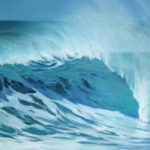By any measure, Mark Ransom has led enough life to fill a dozen autobiographies, taking a wildly circuitous route to his relatively normal existence today in Anchorage, Alaska.
He lives there with his life partner and my second cousin, Panu Lucier. Our fathers were first cousins. Her father arrived in Alaska in 1942 and married an Inupiaq (Native Alaska) woman. Panu was their firstborn; her name means “daughter” in her mother’s language.
We first met Panu and Mark in 2014 when they hosted us in their Anchorage home for a week. Mark astutely guided us on a walking tour around the city, entertaining us with both history and gossip.

Both took us hiking on a glacier at 10 o’clock at night, accompanied us on a road trip to the tiny, historic town of Talkeetna, and stood with us on the roadside as the clouds parted on cue and Denali appeared like some heavenly apparition.
We’ve continued to correspond and this past week, Mark’s Facebook page led me to his unpublished autobiography, just the antidote for isolation ennui.
In his nearly 65 years, Mark writes that he has “marked time as a journalist, a television news anchor, a used car salesman, a software test engineer, a teacher of Japanese language and culture and a senator’s chief of staff…”
He also says he’s “a fellow who drove sled dogs in the arctic, scuba dived on shipwrecks in the tropics, piloted multi-engine aircraft, traveled around the world twice, survived cancer, smuggled human remains out of Japan, saw his death in premonitions, survived a helicopter crash and escaped from a marriage to a Japanese psychopath…” – all of this before earning a bachelor’s degree at 45.
Mark wrote it all down in 2011 in the autobiography “Trails of Kidnap Money” (a nod to his last name), which tells of a life reinvented multiple times and one that took Mark to far corners of the globe.
“I come from a clan cursed by wanderlust,” he writes.
Luckily, Mark also is adept at drawing detailed verbal pictures.
“Once I discovered I could tell a good story just from an experience — common or unusual — then I was often induced to record the experience in a way that I thought interesting or entertaining,” he writes in an email.
Mark’s memory was aided by letters written during military service in Japan, correspondence while working on Guam and miscellaneous clippings and news accounts that “often inspired my personal spin on certain events.”
Sometimes the notes of others helped him fill in the memories, like the musings of his mother during the family’s migration in 1967 from Wyoming to Anchorage.
It was several days before the family of six (plus dog and caged canary) reached Dawson Creek in British Columbia, where the Alaska Highway begins. Eighty miles later, however, the pavement ended and the gravel began.
At this point, “Mom swore the people (coming south) peered back at us with eyes of sympathy.”
At 11, Mark viewed the trip as high adventure as they rumbled over the gravel in a 10-year-old pickup and a ’61 Corvair Greenbriar van, camping most of the way. The family contended with rain, mud, heavy dust, Alaska’s legendary giant mosquitoes, and 18-hour days at 35 miles an hour to prevent tires from being destroyed by the brutal, bone-shaking highway. Tension and suspense reigned as they wondered if they’d survive until the next rest stop with services, which were few.
The road-weary Ransoms arrived in Anchorage 10 days after leaving Wyoming, and their van died as they pulled into the driveway of their new rented home. It would be another 43 years before Mark drove the Alaska Highway again.
By then, it was much more civilized; it had been straightened and paved, and Mark observed that “…towns that were quaint oases of a few buildings in 1967 were, in 2009, larger towns and cities where one could get lost trying to find the ubiquitous Wal-Mart.”
Contact Mark Ransom at [email protected]. For more photos of 1967 Alaska, visit www.facebook.com/elouise.ondash. Want to share your travels? Email [email protected].



